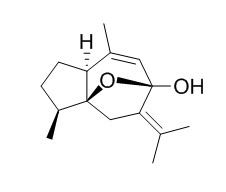Curcumenol
Curcumenol possesses a variety of health and medicinal values which includes neuroprotection, anti-inflammatory, anti-tumor and hepatoprotective activities. It inhibits NF-κB activation by suppressing the nuclear translocation of the NF-κB p65 subunit and blocking IκBα phosphorylation and degradation.
Inquire / Order:
manager@chemfaces.com
Technical Inquiries:
service@chemfaces.com
Tel:
+86-27-84237783
Fax:
+86-27-84254680
Address:
1 Building, No. 83, CheCheng Rd., Wuhan Economic and Technological Development Zone, Wuhan, Hubei 430056, PRC
Providing storage is as stated on the product vial and the vial is kept tightly sealed, the product can be stored for up to
24 months(2-8C).
Wherever possible, you should prepare and use solutions on the same day. However, if you need to make up stock solutions in advance, we recommend that you store the solution as aliquots in tightly sealed vials at -20C. Generally, these will be useable for up to two weeks. Before use, and prior to opening the vial we recommend that you allow your product to equilibrate to room temperature for at least 1 hour.
Need more advice on solubility, usage and handling? Please email to: service@chemfaces.com
The packaging of the product may have turned upside down during transportation, resulting in the natural compounds adhering to the neck or cap of the vial. take the vial out of its packaging and gently shake to let the compounds fall to the bottom of the vial. for liquid products, centrifuge at 200-500 RPM to gather the liquid at the bottom of the vial. try to avoid loss or contamination during handling.
Bioorg Chem.2024, 145:107184.
Nat Prod Commun.2018, 10.1177
Dis Markers.2022, 2022:2380879.
Drug Dev Ind Pharm.2024, 50(11):938-951.
Virus Res.2023, 335:199199.
Food Chem.2016, 191:81-90
Photodermatol Photoimmunol Photomed.2024, 40(1):e12950.
Antioxidants (Basel).2021, 10(10):1638.
Evid Based Complement Alternat Med.2021, 8707280.
Inflammation.2024, 02034-1.
Related and Featured Products
Phytother Res. 2010 Aug;24(8):1213-6.
Inhibitory effects of curcumenol on human liver cytochrome P450 enzymes.[Pubmed:
20148399 ]
Curcumenol, one of the major components of Zedoary turmeric oil, has been widely used to treat cancer and inflammation. As an antibiotic or anticancer drug, Curcumenol is highly likely to be used in combination with various synthetic drugs in most cases, thus it is necessary to evaluate potential pharmacokinetic drug-drug interactions induced by Curcumenol.
METHODS AND RESULTS:
In this study, the inhibitory effects of Curcumenol on seven CYP isoforms were investigated, and the results demonstrated that only CYP3A4 was strongly inhibited (IC(50) = 12.6 +/- 1.3 microM). Kinetic analysis showed the inhibition type was competitive with K(i) value of 10.8 microM. Time- and NADPH-dependent inhibitions were also investigated to show Curcumenol is not a mechanism-based inhibitor. Employing these in vitro data and maximum plasma concentration of Curcumenol in human predicted from beagle dog's in vivo pharmacokinetic data, the change in AUC of victim drugs was predicted to be 0.4%, which suggested that Curcumenol may be safely used without inducing metabolic drug-drug interaction through P450 inhibition. Nevertheless, due to the limited pharmacokinetic data available for Curcumenol in humans, it is still not possible to evaluate its potential clinical effects on human patients from in vitro data.
CONCLUSIONS:
Thus, the magnitude of drug-drug interaction (DDI) induced by Curcumenol warrants further investigation.
Int J Mol Sci. 2015 Mar 6;16(3):5180-93.
Spectrofluorometric and molecular docking studies on the binding of curcumenol and curcumenone to human serum albumin.[Pubmed:
25756376]
Curcumenol and curcumenone are two major constituents of the plants of medicinally important genus of Curcuma, and often govern the pharmacological effect of these plant extracts.
METHODS AND RESULTS:
Additions of these sesquiterpenes to HSA produced significant fluorescence quenching and blue shifts in the emission spectra of HSA. Analysis of the fluorescence data pointed toward moderate binding affinity between the ligands and HSA, with curcumenone showing a relatively higher binding constant (2.46 × 105 M-1) in comparison to Curcumenol (1.97 × 104 M-1). Cluster analyses revealed that site I is the preferred binding site for both molecules with a minimum binding energy of -6.77 kcal·mol-1. However, binding of these two molecules to site II cannot be ruled out as the binding energies were found to be -5.72 and -5.74 kcal·mol-1 for Curcumenol and curcumenone, respectively.
CONCLUSIONS:
The interactions of both ligands with HSA involved hydrophobic interactions as well as hydrogen bonding.



